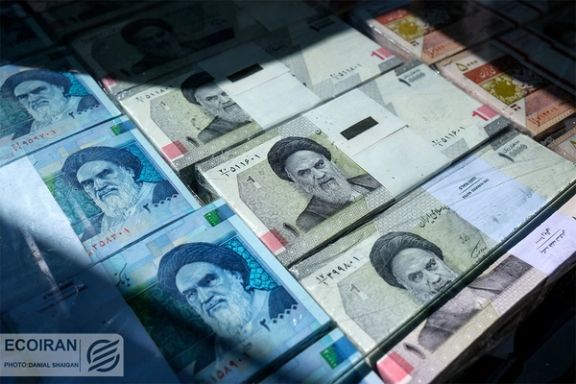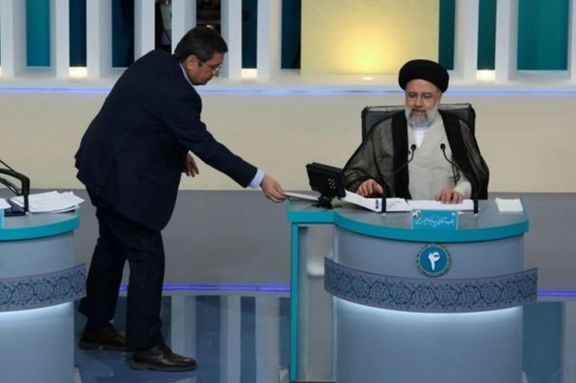Iran's Government Biggest Debtor To Troubled Banks

Iran's President Ebrahim Raisi asserts that his government maintains transparency regarding the previously undisclosed identities of the banking system’s major debtors.

Iran's President Ebrahim Raisi asserts that his government maintains transparency regarding the previously undisclosed identities of the banking system’s major debtors.
An examination of the data from the Central Bank of Iran unveils that his government is actually the largest debtor among them.
“You remember that in an election meeting, they handed the candidates the names of three [major debtors] in sealed envelopes, but now [Economy Minister] Mr. Khandouzi is releasing the financial information of 2,000 companies on [the Central Bank] website for everyone to see,” President Raisi said at a meeting with hardliner student activists on Saturday.
Raisi was referring to a highly sensational presidential election debate in 2021. During this debate, his rival, the former Governor of the Central Bank of Iran, Naser Hemmati, handed him a sealed envelope purportedly containing a list of top debtors to the banking system. Hemmati later said that he had previously provided the names to the judiciary, which was headed at the time by Raisi, on multiple occasions – saying that action was taken. Hemmati added that he himself couldn't announce the names during the debate due to legal constraints.

It has long been an open secret that Iran's predominantly government-controlled banks face a shortage of capital and that their lending policies are influenced by insiders, such as Iran’s clerics.
The ministry of economy defines a 'major debtor' as persons or entities that hold loans worth at least 10% of a bank's total resources and defaulting on the payments.
In November 2021, such loans were estimated to total around $10 billion but the value of these loans would have been 5-6-fold higher in dollar equivalents, at the time they were granted. The Iranian currency dropped significantly from mid-2018, but most of these loans were issued before that period.
Six months after an order by the economy minister mandated them to comply, four state-owned banks, including Bank-e Melli, Iran's largest bank, released their lists of major debtors in April 2022. Subsequently, the Central Bank published its list, encompassing 14 other banks along with their major debtors.
The data published at that time and subsequently has, however, been incomplete and vague.
“What interest rates were charged on the loans granted to major debtors? What guarantees were taken for the loans? How were the borrowers’ credit and guarantee assessed? How much of these debts can be recovered and [the collection of] how much is doubtful or impossible?” an editorial in the reformist news outlet Shargh asked after publication of the first set of lists.
Allegations have persisted that major debtors with poor credit utilize loans to speculate in housing, foreign currency, and gold markets rather than investing in production – contributing to higher inflation rates.
“What were these loans for? Were the loans spent for the purposes indicated on loan application forms? What assets were created by the money taken from the bank and how much added value was produced?” the editorial asked, referring to such allegations.
The public is often led to believe that major debtors to the banking system are individuals and private companies.
But, Iran International’s examination of the data provided by the Central Bank and other banks indicates that the private sector’s share of such loans is minimal.
Instead, entities such as the State Welfare Organization, the National Iranian Oil Company (NIOC), and companies owned by banks, automakers, and several other government agencies emerge as the top debtors.
During his campaign Raisi promised that borrowing from the Central Bank was a “redline” his government would not cross. Government officials, accordingly, claim they are fulfilling this promise.
Experts assert that rather than borrowing directly from the Central Bank to address its budget deficit, the government has significantly increased its borrowing from other banks to obscure its financial activities.
This practice, in turn, puts pressure on the Central Bank to print more money in order to provide loans to these banks – leading to an increase in liquidity and higher inflation, according to these experts. According to Iran International's calculations based on periodic official statements, The Raisi government has been printing the equivalent of $460 million per month, adding to the monetary base.
“The government and government-owned companies’ debts to the banking system have doubled since August 2021 when Raisi assumed office,” Dalga Khatinoglu, an Iran economic analyst and oil expert, told Iran International.
“Debts to the banking system include bonds that the government has issued and forced banks to buy as payment of previous government debts. This is the reason the government’s debts to banks are continuously increasing despite payments claimed to be made,” he said.
“But the government’s debt to the banking system is only a fraction of its overall debts. It has also borrowed very heavily from the Central Banks and owes $100 billion to the National Development Fund. The total amounts to $118 billion, that is, equal to two and half years of the government [operating] budget,” Khatinoglu added.